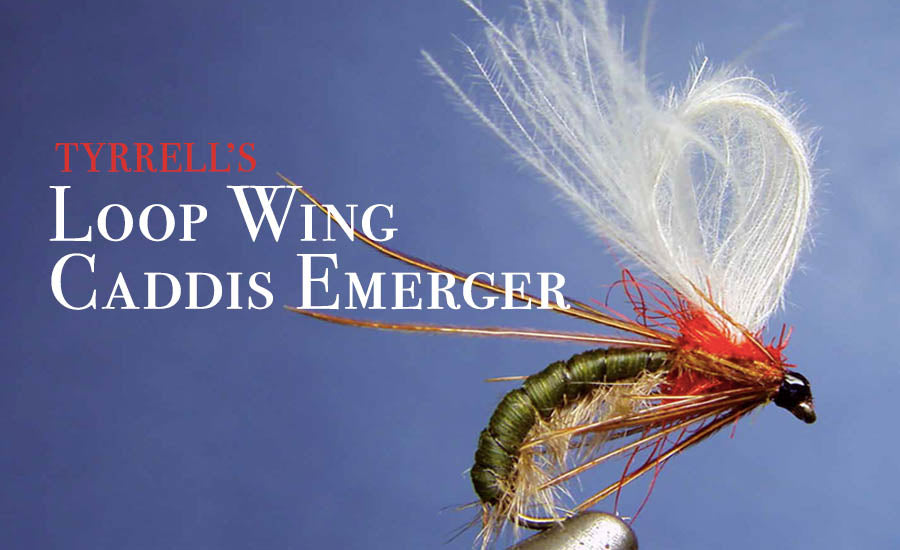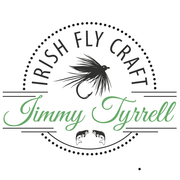Tyrrell's Loop Wing Caddis Emerger - Irish Angler Magazine December 2009
- by James Tyrrell
-

Want to tie a sedge pupa that has never failed to catch trout? Jimmy Tyrrell explains how, as he reveals this sure-fire pattern.
I have been tying flies for many years and during that time I have come up with a few patterns which have given me some fantastic river and lough fishing. Some of these patterns are quite straightforward to tie, while others have had a bit more work in them.
I am going to show a fly that has probably given me better fishing on the river than any other fly. I would say that this fly has consistently caught me more fish than any other fly that I have tied. I have yet to try this on the loughs, but I cannot see how it would not catch fish. I like to tie my river flies as near to realistic as I can and I think I’ve got this pattern just right. It is one of my favourite patterns when the sedges come on.
"I would say that this fly has consistently caught me more fish than any other fly that I’ve tied."
I like experimenting with different styles and materials. There is so much material on the market at the moment that we are spoilt for choice. One of the materials required for this fly is Flexibody. Flexibody is almost the same as an elastic band only not as thick. It comes in a huge variety of different colours and widths. You can create some nice realistic nymphs with it. It’s quite easy to use; you just cut at an angle to create a tying-in point, and wind up the hook shank in overlapping turns, giving a really nice segmented body.
When the trout take this they really attack the fly and it is easier to remove the fly without touching the fish if you are releasing it. Therefore if I tie this pattern on barbless hooks or I just crimp the barb on the hook, which does just as well. You also do less damage to the CDC loop wing if you are not struggling to remove the fly from the trout’s mouth.
There are four stages in the development of the caddis: from the egg to the larva to the pupa and finally the winged insect. It is the pupal stage, just before the insect reaches the surface and flies away, that I am trying to imitate and I think that this fly really does that. The pupa comes to the surface in mid-water or climbing up vegetation where it hatches into the winged insect. When the sedges come on I can honestly say that I have never failed to catch trout with this fly, it looks so realistic under the surface.

I tie in a couple of CDC plumes over the top of the thorax, which allows the fly to sit directly under the surface looking like the sedge trying to get through up on to the surface of the river. The CDC only comes into play as a float, allowing the fly to sit nicely just under the surface and to drift down over any rising fish. I only use two feathers as I find too much CDC does not allow the fly to sit correctly under the surface.
I don’t think the colour of the CDC makes any difference, as it is what is under the water that is important. I like to use white as it is much easier to see when the sun is setting. I also like to gink up the CDC feathers because when you are catching fish and the CDC is getting drowned regularly it allows the fly to sit up a lot longer and you’re not having to false cast so much trying to dry the fly.
I prefer to tie the plumes in as a loop as very little of the CDC is touching the top of the thorax this allows all of the fly to sit under the surface. I like to tie all of my emergers this way. I only use two feathers as I find too much CDC does not allow the fly to sit directly under the surface.
"The fly takes a bit of tying but when mastered you will find that it was well worth the effort."
The other good thing about this fly is after a few outings the fly starts to take a bit of a battering and the CDC starts to come apart. What I do when this happens is to cut away any remaining CDC and use the fly as a wet sedge pupa. This works quite well too.
The underwater picture really shows why this fly works so well. You can see how it sits really well under the surface with the CDC holding it there, and all the small pockets of air that get trapped between the fibres and materials must really add something to the fly as regards colours as the light hits off it at different angles. Also you can see how the Flexibody has given the emerger that really nice segmented body. I think that is what gives it that lifelike appearance.
The fly takes a bit of tying but when mastered you will find that it was well worth the effort. If you are having any problems tying this fly, please feel free to contact me.
I would say that this fly has consistently caught me more fish than any other fly that I have tied.
The Loop Wing Caddis Emerger
| Hook: |
Size 12 Kamasan B100 grub hook |
| Rib: | Very fine nylon |
| Underbody: | Ostrich herl |
| Abdomen: | Brown or olive Flexibody |
| Wing Case and Legs: | Cock pheasant tail fibres |
| Thorax: | Hot orange seal’s fur |
| Wing: | Two CDC plumes tied in as a loop |
Tying Instructions
 Step One: Tie in two stands of ostrich herl, a length of nylon and one strand of Flexibody at the bottom of the bend of the hook.
Step One: Tie in two stands of ostrich herl, a length of nylon and one strand of Flexibody at the bottom of the bend of the hook. Step Two: Wind the Flexibody back up the hook in overlapping turns and tie down about three quarters of the way up the hook shank.
Step Two: Wind the Flexibody back up the hook in overlapping turns and tie down about three quarters of the way up the hook shank. Step Three: Hold the ostrich herl under the body and catch in underneath by winding the nylon back up the body for about five turns.
Step Three: Hold the ostrich herl under the body and catch in underneath by winding the nylon back up the body for about five turns. Step Four: Tie in about a dozen or more strands of cock pheasant tail fibres.
Step Four: Tie in about a dozen or more strands of cock pheasant tail fibres. Step Five: Tie in two CDC feathers, loop forward and tie down.
Step Five: Tie in two CDC feathers, loop forward and tie down. Step Six: Dub on some orange seal’s fur for the thorax and wind on to building up a neat thorax.
Step Six: Dub on some orange seal’s fur for the thorax and wind on to building up a neat thorax. Step Seven: Pull the cock pheasant tail fibres forward evenly either side of the thorax leaving two fibres behind for the horns and tie down.
Step Seven: Pull the cock pheasant tail fibres forward evenly either side of the thorax leaving two fibres behind for the horns and tie down. Step Eight: Divide the cock pheasant tail fibres leaving two behind to act as horns and stroke downwards between your finger and thumb and back under the hook to act as the legs and tie down.
Step Eight: Divide the cock pheasant tail fibres leaving two behind to act as horns and stroke downwards between your finger and thumb and back under the hook to act as the legs and tie down. Step Nine: Whip finish and varnish.
Step Nine: Whip finish and varnish.Tying Tips
Tip 1: Make sure that the hook shank is even with no big bumps before you wind on the Flexibody.
TIP 2: When you are tying in the CDC, make sure that you are far enough back from the eye as there as there is a lot of work to be done at the thorax.
TIP 3: Do not overdo the seal’s fur. A small pinch is sufficient.





